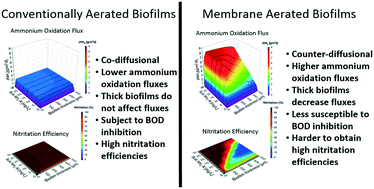Enhancing ammonium oxidation fluxes and nitritation efficiencies in MABRs: a modeling study†
Abstract
The membrane aerated biofilm reactor (MABR) is a novel technology based on gas-supplying membranes that supply dissolved O2 (DO) to biofilms growing on the membrane surface. The counter-diffusion of DO, supplied from base of the biofilm, and the electron donor, supplied from the bulk liquid, make membrane-aerated biofilms (MABs) behave differently from conventional, co-diffusional biofilms (CABs). We used 1-D biofilm modeling to explore ammonium oxidation fluxes, JNH4, and nitritation efficiencies, ηNO2, for MABs and CABs under nitrifying conditions. The JNH4 for MABs has three regions of behavior: biomass limitation at low biofilm thicknesses, single substrate limitation for moderate thicknesses, and dual substrate limitation at higher thicknesses. For both MABs and CABs, for a given bulk DO and NH4+ concentration, the JNH4 increases with increasing biofilm thicknesses up to a critical value. For further increases in thickness, CAB fluxes remain the same, while MAB fluxes decrease. CABs typically have lower maximum JNH4 values than MABs, but achieve high ηNO2 values more easily. For MABs, ηNO2 is high as long as NH4+ fully penetrates the biofilm. A low membrane mass transfer coefficient, Km, results in lower DO concentrations at the membrane surface, decreasing JNH4 values but increasing the ηNO2. The effects of a low Km can be offset by increasing the O2 supply pressure. Increasing the bulk DO can significantly increase JNH4 values, especially for thick biofilms. Bulk BOD has a detrimental effect on JNH4 values, but MABs are less susceptible to BOD inhibition than conventional biofilms. Biofilm roughness significantly impacts both JNH4 and ηNO2 values, depending on the biofilm thicknesses and substrate concentrations, so average biofilm thicknesses should be used with caution. Results from this study are consistent with experimental results from the literature. This work provides a mechanistic understanding of MABR behavior. This can allow researchers to better design experiments and better interpret results, and for practitioners to develop more effective applications.



 Please wait while we load your content...
Please wait while we load your content...